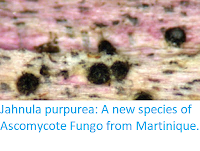Ascomycete Fungi of the genus Cylindrocladiella are found in tropical, subtropical and temperate soils around the world, though they are at their most diverse in the tropics. They are primarily saprophytes (organisms that obtain energy by breaking down decaying dean matter), but several species have been shown to cause plant diseases at least opportunistically, and their role as pathogens may be greater than is currently understood.
In a paper published in the journal MycoKeys on 15 March 2018, Nam Pham of the Department of Plant and Soil Sciences at the University of Pretoria, Irene Barnes of the Department of Department of Biochemistry, Genetics and Microbiology, also at the University of Pretoria, ShuaiFei Chen of the China Eucalypt Research Centre of the Chinese Academy of Forestry, Thu Pham of the Forest Protection Research Centre of the Vietnamese Academy of Forest Sciences, Lorenzo Lombard of the Westerdijk Fungal Biodiversity Institute, Pedro Crous, also of the Department of Department of Biochemistry, Genetics and Microbiology at the University of Pretoria, and the Westerdijk Fungal Biodiversity Institute, and Michael Wingfield, also of the Department of Plant and Soil Sciences at the University of Pretoria, describe five new species of Cylindrocladiella from Vietnam and Malaysia.
The first new species described is named Cylindrocladiella arbusta, in reference to the plantation where it was discovered, in Nghe An Province, Vietnam. The Fnngus was isolated from soil in a Black Wattle, Acacia mangium, plantation, and formed white or buff colonies in culture.
Cylindrocladiella arbusta. (A)–(C) Penicillate conidiophores. (D)–(F) Obpyriform to lanceolate vesicles. (G) & (H) Penicillate conidiogenous apparatus. (I) & (J) Subverticillate conidiophores. (K) Conidia. Scale bars: (A) = 20 μm (apply to (B) & (C)); (D) = 10 μm (apply to (E) & (F)); (G) = 10 μm (apply to (H) – (K)). Pham et al. (2018).
The second new species described is named Cylindrocladiella malesiana, in reference to Malaysia. as it was first discovered in Sabah State in Malaysian Borneo. This species was also isolated from soil in a Black Wattle, Acacia mangium, plantation, and formed buff to hazel colonies in culture.
The third new species described is named Cylindrocladiella obpyriformis in reference to the terminating vesicles (cells at the tips of the hyphae) which are Pear shaped (obpyriform). This species was isolated from soil from a hybrid Acacia plantation in Tuyen Quang Province, Vietnam, and forms buff to yellow-grey colonies in cultivation.
The fourth new species is named Cylindrocladiella parvispora, in reference to the small conidia (spore-producing bodies) of the species. This species was also isolated from soil from a hybrid Acacia plantation in Tuyen Quang Province, Vietnam, and forms buff to honey colonies in cultivation.
The final new species described is named Cylindrocladiella solicola, in reference to the soil where it was found. This species was also isolated from soil from a hybrid Acacia plantation in Tuyen Quang Province, Vietnam, and forms buff to yellow-grey colonies in cultivation.
See also...
Cylindrocladiella malesiana. (A)–(C) Penicillate conidiophores. (D)–(F) Fusoid to lanceolate vesicles. (G) & (H) Penicillate conidiogenous apparatus. (I) & (J) Subverticillate conidiophores. (K) Conidia. Scale bars: (A) = 20 μm (apply to (B) & (C)); (D) = 10 μm (apply to (E) & (F)); (G) = 10 μm (apply to (H)–(K)). Pham et al. (2018).
The third new species described is named Cylindrocladiella obpyriformis in reference to the terminating vesicles (cells at the tips of the hyphae) which are Pear shaped (obpyriform). This species was isolated from soil from a hybrid Acacia plantation in Tuyen Quang Province, Vietnam, and forms buff to yellow-grey colonies in cultivation.
Cylindrocladiella obpyriformis. (A)–(C) Penicillate conidiophores. (D)–(F) Obpyriform vesicles (G) & (H) Penicillate conidiogenous apparatus. (I) & (J) Subverticillate conidiophores. (K) Conidia. Scale bars: (A) = 20 μm (apply to (B) & (C)); (D) = 10 μm (apply to (E) & (F)); (G) = 10 μm (apply to (H)–(K)). Pham et al. (2018).
The fourth new species is named Cylindrocladiella parvispora, in reference to the small conidia (spore-producing bodies) of the species. This species was also isolated from soil from a hybrid Acacia plantation in Tuyen Quang Province, Vietnam, and forms buff to honey colonies in cultivation.
Cylindrocladiella parvispora). (A)–(C) Penicillate conidiophores. (D)–(F) Fusoid to cylindrical vesicles. (G) & (H) Penicillate conidiogenous apparatus. (I) & (J) Subverticillate conidiophores. (K) Conidia. Scale bars: (A) = 20 μm (apply to (B) & (C)); (D) = 10 μm (apply to (E) & (F)); G = 10 μm (apply to (H)–(K)). Pham et al. (2018).
The final new species described is named Cylindrocladiella solicola, in reference to the soil where it was found. This species was also isolated from soil from a hybrid Acacia plantation in Tuyen Quang Province, Vietnam, and forms buff to yellow-grey colonies in cultivation.
Cylindrocladiella solicola. (A)–(C) Penicillate conidiophores. (D)–(F) Broadly clavate to lanceolate to fusiform vesicles. (G) & (H) Penicillate conidiogenous apparatus. (I) & (J) Subverticillate conidiophores. (K) Conidia. Scale bars: (A) = 20 μm (apply to (B) & (C)); (D) = 10 μm (apply to (E) & (F)); (G) = 10 μm (apply to (H)–(K)). Pham et al. (2018).
See also...
Follow Sciency Thoughts on Facebook.











